World Food Day 2019
October 16, 2019Belonging
Gethsemane Community Inc has reached out to people with disabilities who are lonely and socially isolated at Christmas since 1994. Stimulated by awareness of the poverty of residents of boarding houses, we packed gift bags of toiletries, socks, underwear and lollies for hundreds of people each year. As reforms took effect, their situation improved, though they remained poor and lonely. We followed former residents to group homes and aged care facilities. Along the way we added other aged care residents who had no family contact. That data base now stands at 960 and all receive a gift bag of toiletries, socks and lollies.
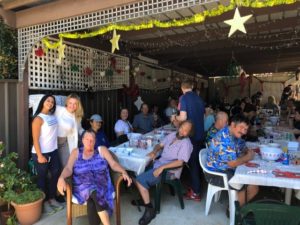 A coded program, which safeguards privacy, allows parishes and schools to send Christmas cards to these people, with each person receiving about 10 cards. Most of them never receive personal mail.
A coded program, which safeguards privacy, allows parishes and schools to send Christmas cards to these people, with each person receiving about 10 cards. Most of them never receive personal mail.
Some years ago, I was visited by a nurse from a team which looks after people with complex mental health issues. She told me that the previous Christmas she had been so worried about the poverty of her clients that she bought a case of mangoes and gave one to each person, so they had something to wake up to on Christmas Day. I thought we could do better than that.
This year, we will prepare hampers for 460 clients of mental health and drug treatment teams around the Inner West of Sydney. We provide enough general food to cover meals for three days: tins of ham, chicken, tuna, salmon, mushrooms in butter sauce, baked beans, spaghetti, then tea, coffee and cracker biscuits. Festive food such as mini Christmas puddings and cakes, long-life cream and fruit in juice is added. A calendar for clients to record medical and Centrelink appointments and a gift of aftershave for men and perfume for women goes on top.
Medical teams collect the hampers and give them to clients just before Christmas. Lonely people are able to celebrate Christmas with the rest of us.
On Christmas Day, we welcome 60-70 people with disabilities to Christmas lunch here. It is a fun time. The invitations say 11am, but people start drifting in by 10am. Some people have been coming to this celebration for many years, and they sit down with others they have come to know here. Early birds start on drinks and nibbles. A bus arrives with 30 residents from a local boarding house and the tables set up under our carport start to fill up. More arrive from group homes all around the area.
Some start to get restless and want lunch, so we start serving the main course, even as others start on nibbles. One man wants to remain on the nature strip so he can have his bourbon with the meal. Some are ready for dessert, so plates are taken to them. When all are finished, it is time for presents. Gift bags are distributed and contents compared. Some guests stand up and start walking down the drive. By 1pm, it is over for another year.
View the Gethsemane Community website
Visit the World Food Day website
Myree Harris rsj
Image provided by Sr Myree Harris. Used with permission.
Newly elected Congregational Leadership Team and Thanks
October 13, 2019
The Sisters of Saint Joseph would like to thank you for your prayerful support for their 27th General Chapter.
Anti-Poverty Week 2019
Anti-Poverty Week is being held from 13 – 19 October 2019.
Poverty is lack of shelter
Poverty is being sick and not being able to see a doctor
 LOOK AT THE BLACK IN THE IMAGE
LOOK AT THE BLACK IN THE IMAGE
Extreme poverty is living on less than $1.90 per person per day. Ten percent of the world population live in extreme poverty. Of those in extreme poverty half are children.
LOOK AT THE PURPLE AND RED IN THE IMAGE
Relative poverty is living on less than $5.50 per person per day. The problem with relative poverty is that a failed crop, a natural disaster or illness means that a family can tip rapidly into extreme poverty. Nearly half the world population lives on less than $5.50 per day.

LOOK AT THE YELLOW AND THE GREEN
If the richest countries gave $1 per $100 of gross national income per annum it has been calculated that extreme poverty could be overcome. Australia invests 21 cents per dollar of gross national income and is due to reduce it to 19 cents.
Diane Moore rsj
Figures quoted are from antipovertyweek.org.au
A Day in the Life: Spiritual Director
October 8, 2019To live and minister in the tranquil and picturesque rural village of Forth in north-western Tasmania has been a wonderful blessing for me. As I gaze down the valley and across to Bass Strait, I thank God every day!
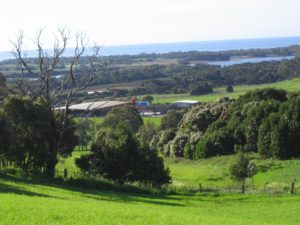 No two days are the same in this small spirituality centre. I am the sole resident, supported by an office volunteer one afternoon a week and a librarian who volunteers one day per week, so having a plan for the day is not necessarily how it will unfold.
No two days are the same in this small spirituality centre. I am the sole resident, supported by an office volunteer one afternoon a week and a librarian who volunteers one day per week, so having a plan for the day is not necessarily how it will unfold.
Spiritual Direction is offered on a part-time basis by four female directors, two of whom live within half an hour of the Centre and one lives nearby. Formal spiritual direction is only one aspect of the larger canvas of spirituality in which we are involved every day.
Throughout the year we offer live-in retreats – directed, guided or private – at times that suit retreatants. We have en-suite accommodation for a maximum of two people at any one time. Of course, one’s cooking skills are hopefully enhanced with the variety of opportunities that come from frequent visitors and retreatants. One needs to have an assortment of “goodies” in the deep freeze in preparation for visitors, seminars and afternoon teas. It would be true to say that I’ve had a great deal more “chef” practice here than in my younger days. Along with being invited to trust as part of the spiritual journey I am frequently invited to take a “leap of faith” along the culinary highway!

Two of us have professional supervision training which has enabled us to offer individual supervision for chaplains in Aged Care; ministry students in training and other professionals. In a town approximately forty (40) minutes from the Centre we supervise a 90-minute Ministry Reflection group open to chaplains from aged care facilities, hospitals and ministers. This has continued for many years to nourish women and men involved in these ministries. It has developed to the extent that at times when the facilitator is unable to be present the group nominates an experienced person to take that role. The group has also decided to have a reflection day each year, showing a heart-warming experience and commitment to their ministry.
Another ‘day’ is the Monday monthly – “Spirituality in the Coffee Shoppe” 10.30am-12noon.
There is no booking…people just turn up from the various towns/villages, make a cup of tea or coffee, introduce themselves, find a seat and begin to share some of the issues around faith or Church or morality, that are of concern to them. This is quite a remarkable time as people from all walks of life and experience discuss what’s on their minds with quite some passion at times. We learn a great deal from this time of sharing our questions, experience, our struggles and our faith.
 Some days people want a chat on the phone or a time to come and talk or invite you to meet them somewhere. Or it might be the gardener or the cleaner or librarian!!! These unplanned ‘moments’ invariably offer opportunities for friendliness and pastoral care and two of us try to respond to these requests whenever possible. I have come to realise more deeply that hospitality, attentiveness and care are a significant ‘underpinning’ for all that is offered here. God’s Spirit is at work through these expressions of love for one another. In the words of John O’Donohue: “in the kindness of care the Divine comes alive in us.”
Some days people want a chat on the phone or a time to come and talk or invite you to meet them somewhere. Or it might be the gardener or the cleaner or librarian!!! These unplanned ‘moments’ invariably offer opportunities for friendliness and pastoral care and two of us try to respond to these requests whenever possible. I have come to realise more deeply that hospitality, attentiveness and care are a significant ‘underpinning’ for all that is offered here. God’s Spirit is at work through these expressions of love for one another. In the words of John O’Donohue: “in the kindness of care the Divine comes alive in us.”
Marg Chandler rsj
A Mellow Heart
This month’s foray into the Little Brown Book Too draws us into an incident which shows how Mary’s warm heart and generous spirit helped her to have an impact on another person.
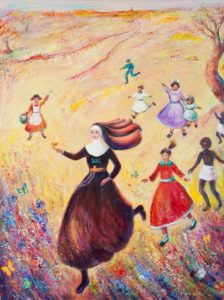 Sister Irene told of a time when Mary sent for her:
Sister Irene told of a time when Mary sent for her:
“Do you want me, Mother?” she asked.
“Yes,” was the answer. “I want to beg your pardon for the impatient way I spoke to you when you came to me this morning. I fear I have given you pain and I am sorry for having done so.”
She may have felt irritable and thought she had betrayed it in her words or manner, but I had no sense of this and told her so, for she had been most gentle and kind to me.
This little connection came from Mary’s readiness to trust in the goodness of another. It brings to mind Ronald Rolheiser’s wisdom that:‘Sanctity is about having a mellow heart and spirit.’
Most would agree that it was because Mary’s heart was mellow that: ‘she did not lose touch with the people’ (Paul Gardiner sj)
 The above is an extract from The Little Brown Book Too (pages 36-37)
The above is an extract from The Little Brown Book Too (pages 36-37)
© Sue and Leo Kane 2011
Used with the kind permission of the publishers, St Paul’s Publications
Available online and from some Mary MacKillop Centres.
Download the print version of this reflection (PDF)
Image: © Veronika Dimac – InJoy International: Used with permission of the artist.
Climate Strike
Reasons to Strike
Pope Francis calls us to care from our common home, telling us, as people of faith, that living our vocation to be protectors of God’s handiwork is essential to a life of virtue; it is not an optional or a secondary aspect of our Christian experience.
As if we needed any more motivation to act for climate justice, The Guardian news service provides us with over 20 reasons why the worldwide youth climate strike movement is essential. Here is a taste, a convincing affirmation for those of us who chose to participate in the Youth Climate Strike.
- Strike because the people who did the least to cause this crisis suffer first and worst – the people losing their farms to desert and watching their islands sink beneath the waves aren’t the ones who burned the coal and gas and oil.
- Strike because this could be the great opportunity – and maybe the last opportunity – to transform our society towards justice and towards joy. Green New Deals have been proposed around the world; they are a way forward.
- Strike because what we do this decade will matter for hundreds of thousands a year.
- Strike because indigenous people around the world are trying to protect their rightful land from the coal and oil companies – and in the process protect all of us.
- Strike because science is real, because physics exists, because chemistry matters.
- Strike because the world we were given is still so sweet. (19/9/19, The Guardian)
And so many Sisters, Associates, Youth Volunteers and Josephite Friends, from around Australia and beyond, joined with young activists to march for Climate Justice.
In Ireland:
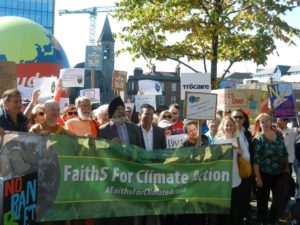
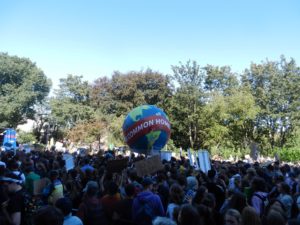
In Sydney:


In Brisbane:
Josephite Sisters joined Youth, Families, Faith Groups, Union representatives and other supporters in the climate action march held on Friday afternoon 20 September 2019, in Brisbane.
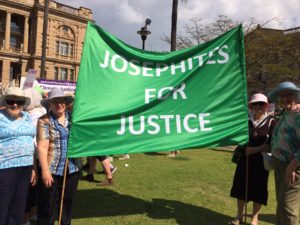
It was evident that those who marched were concerned about the earth, water and the welfare of future generations. There was also a sense of urgency. We have no time to wait for action. The time to act is now.
Each of us can take some action through prayer, saving water, saving electricity, buying and using less products and recycling.
We will continue to support our youth and act for climate change in our actions, prayers and advocacy work.
In Perth:
As Forrest Place in Perth bulged with the thousands of students and adult workers and supporters, the voices of the organisers were heard over the masses. The walk down William Street and onto Elizabeth Quay was peaceful and passionate, with chants of what do we want… climate justice and more. The student leaders were supported by Trade Union members and individuals, some leading small children and infants, with slogans like… give me a future…
As the news of the hundreds of rallies came through social media, and news outlets across the world, one could only marvel with emotion at ‘the power of one’, Greta Thunberg who has shown in her speeches and responses that she has a comprehensive grasp of the climate crisis, ( she has studied all the reports of the IPCC) and who has brought millions with her in this campaign.
It was amazing to be part of such a mass of humanity, wanting to proclaim that together we must act to save our planet.
Let us continue to act, to lobby our members in Parliament, to do what is right, not just what is economically profitable, to create jobs in renewable energy, and to think and speak with vision for the good of the people and the planet.
Karen Oxley
Year of Indigenous Languages: Italian and Pidgin English
The United Nations has declared 2019 as the International Year of Indigenous Languages. To celebrate, for each month this year, you’re invited to view greetings for different languages.
For October we feature the languages Dutch and Gaelic:
Italian

Papa Francesco ci dice che “I popoli indigeni, con la loro varietà di lingue, culture, tradizioni e conoscenze ancestrali, ci ricordano che siamo tutti responsabili per la cura del creato che Dio ci ha affidato”.
Preghiamo che Dio benedica tutti i popoli indigeni del mondo e che nel dialogo continueremo sempre alla ricerca di cio che ci unisce.
Pope Francis tells us that “The indigenous peoples, with their diverse languages, cultures, traditions and ancestral knowledge, remind us that we are all responsible for caring for God’s creation with which we have been entrusted.”
We pray that God bless all the indigenous peoples of the world and, that in dialogue with them, we will continue to discover all that which unites us.
Pidgin English
 Today, there are 851 languages spoken in Papua New Guinea. These languages are spoken by the tribal groups inhabiting the country (“Papua New Guinea has 832 living languages (languages, not dialects)) making it the most linguistically diverse place on Earth.
Today, there are 851 languages spoken in Papua New Guinea. These languages are spoken by the tribal groups inhabiting the country (“Papua New Guinea has 832 living languages (languages, not dialects)) making it the most linguistically diverse place on Earth.
Bikpela hamamas ikam long yupela olgeta! Dispela yia em i yia bilong tok ples.
Olsem na nau mipela tok olsem yumi salim ting ting lotu igo long olgeta lain bilong taim bipo, taim bilong ol tubuna man na tubuna meri.
Yumi tok save olsem taim bilong ol tubuna ol nau sindaun wantaim papa yumi askim ol long lukautim olgeta pikini, lapun man, lapun meri, ol sik lain, ol lik lik na bikpela samting na graun blo ples yumi sindaun. Yumi askim papa na bihanim tok save na ting ting bilong em.
Long nem bilong bik man na nem Jesus yumi askim.
The very rough English translation is:
Sending you happy peace today during a year in which we celebrate the languages of our tribes.
Firstly, we honour and send our prayers to our ancestors.
We ask our ancestors and God who now watch over every person (young and old) and all living things and to help us look after each other and take care of the world we share. Help us live the word of God through our thoughts and actions.
In Jesus name we pray.
Image of Rome by Free-Photos from Pixabay. Image of Alotau Beautiful Child by Image by JulesR from Pixabay. Both images used with permission.
The 27th General Chapter of the Sisters of Saint Joseph
October 7, 2019The 27th General Chapter of the Sisters of Saint Joseph is underway at St Joseph’s Conference Centre at Baulkham Hills, Sydney.
The 63 Chapter members, voted as delegates by the Sisters in their Regions, are involved in discerning the future of the Congregation and will elect a new Congregational Leader and Councillors. All the Sisters and some of their affiliates have been engaged in a year-long process of prayer, reading, reflection and contemplative dialogue in preparation for this event.
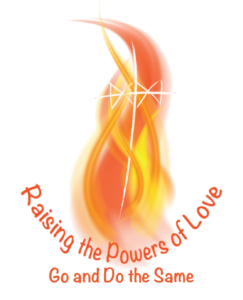 The theme of the Chapter is Raising the Powers of Love, taken from Teilhard de Chardin’s insights. The Chapter gospel story is the parable of the Good Samaritan.
The theme of the Chapter is Raising the Powers of Love, taken from Teilhard de Chardin’s insights. The Chapter gospel story is the parable of the Good Samaritan.
Facilitator Judith King explained Chapter as: “a way of dreaming, a way of thinking, a way of organising, a way of keeping true to the Gospel – a journey of faith and prayer, a discernment.”
Women and men with various relationships to the Sisters visited the Chapter and spoke about how they were influenced by the charism in their work, and offered challenges that the Chapter could consider.
Clyde Rigney, a Ngarrindjeri Elder, travelled from South Australia to address the Chapter. Others represented organisations such as Mary MacKillop Today, Global Catholic Climate Movement, Josephite Heritage Centres, and Australian Plenary Council 2020.
They spoke of their connection to the charism in the places they worked – in schools, as young adults involved in social justice, in running a social service organisation, being a Josephite affiliate leading the chaplaincy team in a large hospital, and as a Josephite Associate/Companion. They encouraged Sisters to trust them as partners in living the charism.
The flow of messages of prayer and support has greatly encouraged the Chapter members. The Chapter is supported by an enthusiastic group assisting with prayer, health and well-being, hospitality, minute taking, translating and communications.
Anne Burke rsj
View some photos from Chapter in the gallery below:
Pray with the Sisters for their 27th General Chapter
